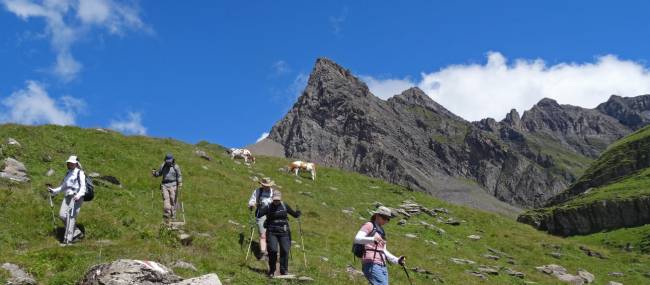
Tips about hiking in the Bernese Oberland | John Millen
Blog home / Guide to Hiking in the Bernese Oberland
The Bernese Oberland, or literally the Bernese Uplands, are a large section of extensive mountains, moors, forests and glaciers that cover the central section of Switzerland. With its rich flora and fauna and fine views, the Bernese Oberland offers the ideal introduction to hiking in the Swiss Alps. In this part of Switzerland, choose from walks with different grades and distances.
You're probably attracted by the classic views of the peaks of the Eiger, Monch and Jungfrau overlooking the valley towns of Grindelwald and Lauterbrunnen. To organise your self guided walking holiday in the Oberland, use this handy guide. And if you're totally convinced that this is the travel destination of your dreams, do have a look at our range of fully supported, hotel-based walking holidays in the Bernese Oberland.
Best Time of Year for Walking In The Bernese Oberland
The best time for a hiking holiday in the Bernese Oberland is June through to September. Travelling in May can be fine for the lower valleys when beautiful flowers spring up. Higher up there will still be snow, which hangs around typically above 2500 metres until at least mid-June.
May and September in the Oberland are drier months than June, July and August. Temperatures fluctuate between 8-23 degrees C during an average day in the Bernese Oberland Valley from May to September and the monthly rainfall varies from 100-150mm in these months.
Highlights of Walking in the Bernese Oberland
Classic Alpine Peaks
Trekking beside classic Alpine Peaks like the Wetterhorn, Eiger, Monch and Jungfrau is in some ways unsurpassed anywhere else in the world. Cross over the classic passes of the Grosse and Kleine Scheideggs and get up close and personal to the Reichenbach Falls where Sherlock Holmes embraced death with Professor Moriarty in the book 'The Adventure of the Final Problem'.
Valais Region
The Matterhorn in the Valais canton (state) dominates several walks from Zermatt, but there are also views to the Breithorn, Taschhorn, Liskamm and Monte Rosa, all famous Swiss mountain peaks.
Flora & Fauna
The species and profusion of flowers and colours that you can find here throughout the year is beautiful. In terms of fauna, look out for the mountain choughs, nutcrackers, siskins and falcons. Occasionally you may even spot a grand golden eagle riding the thermals up into the sky. Marmots call out from the alps and there’s the occasional chamois or ibex.
Meiringen Village
See the old church with its excavated foundations underneath which reveal layers of older churches back to the 9th century. Try a local meringue in Meiringen, the home of the dessert. Visit the Aare gorge and the Reichenbach waterfall.
Lauterbrunnen
This village nestles deeply in a glacial shear sided valley which boasts dozens of waterfalls and base jumpers! The village of Lauterbrunnen is dominated by the flanks of the Jungfrau and the Silberhorn.
Zermatt
A famous winter sports town with a great summer mountaineering and walking reputation. Zermatt is a commercial and tourist centre across the Rhone valley from the Bernese Oberland, in the Swiss Valais, but it also brims over with tradition; wooden barns jostle under modern blocks, with goats and horse drawn carriages sharing the road with modern electric cars. Walk under the flanks of the Matterhorn and round to the pretty hamlet of Zmutt for a crêpe and a beer.
Food & Drink on Your Bernese Oberland Walks
In the area, you can find a typical mix of Germanic/Italian food with an alpine twist. Pastries, pizzas, raclette or fondue are well represented in the Bernese Oberland. Have some solid rib sticking hearty food, Swiss beef or even chamoix cuts in thick sauces with croquette potatoes. Accompany your meal with red Dole wine or Feldschlossen beer. Why not try Swiss Alpine cheese? It’s ubiquitous and often sold from 'honesty fridges' by some farms - the tastes vary significantly.
Other Reasons for Hiking in the Bernese Oberland
Flower lovers will appreciate the alpine pastures of the Bernese Oberland be speckled and resplendent with blooms especially from June to mid-July. The pastures are then usually cut a couple of times for winter feed, and then dry out in the high summer, before turning golden in the autumn.
During long summer days, you can see magnificent alpenglow over the mountains when the peaks fade from gold to red, to pink and purple, to grey. Depending upon the aspect of the mountains this can happen early in the morning or at dusk.
How to Get to the Bernese Oberland - and Away
Ideally you fly into Zurich or Basel Airports and then take a train to Meiringen. From Zurich trains take 2.30-2.50 hours, changing at Luzern or Bern and Spiez before you arrive in the Bernese Oberland. From Basel trains take around 3 hours. Leaving Zermatt, the easiest way is to book a train (4 hours) to Geneva Airport via Visp.
More Information About Walking in the Bernese Oberland
Our walking holidays in the Bernese Oberland and Zermatt are from easy to moderate grading. Walking in Switzerland does inevitably mean that you will have some steep gradients (even at the easier end of the scale) to contend with. Follow the links to find out more about the popular walking routes in Switzerland, some fantastic summer strolls in the Swiss Alps, or read the tale from one of our previous hikers in the Bernese Oberland.
Contact the Walkers' Britain team to organise your fully supported, self guided hiking holiday in the Bernese Oberland. Or
ask us to call you back.